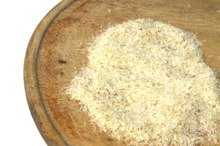Peppermint Allergy Symptoms
Peppermint is a plant that used primarily for use in cooking and as a dietary supplement. The herb is used in candy, hot chocolate and other baked goods. As a supplement, peppermint has been used to treat digestive conditions and depression but may cause adverse reactions in some people. Although Medline Plus states that peppermint is likely safe for use, call your doctor if you notice unpleasant symptoms develop after eating peppermint or taking it in supplement form. Peppermint allergy signs and symptoms will be similar to food allergy symptoms.
Peppermint Allergy
Drugs.com states that peppermint oil can cause allergic reactions that cause the skin to flush, headaches and contact dermatitis 2. Depending on the type of allergic reaction you have to peppermint, your symptoms may vary and can differ in levels of severity. An allergic reaction to peppermint is caused by the immune system overreacting to the substance. If your body doesn’t identify the peppermint as a safe substance, it will defend itself by creating specific antibodies that trigger other chemicals in the body. The chemical reaction is what causes most signs and symptoms.
- Drugs.com states that peppermint oil can cause allergic reactions that cause the skin to flush, headaches and contact dermatitis 2.
Ingested Signs and Symptoms
Is Peppermint Tea an Appetite Suppressant?
Learn More
If you take peppermint orally, your symptoms can affect your skin, lungs, sinuses and digestive system. An allergic reaction to peppermint can cause your skin to become irritated, inflamed and swollen. Nausea, diarrhea, vomiting and stomach cramping are all signs of an allergic reaction after eating peppermint.
Contact Dermatitis
Contact dermatitis is an allergic skin reaction that is triggered whenever your skin comes into direct contact with peppermint oil, the actual plant or any other form of peppermint. Contact dermatitis causes the skin to become red, inflamed and swollen in the area that was exposed to the substance. This skin rash is treated by washing the area and applying a steroid-based cream, such as hydrocortisone.
Extreme Symptoms
Peppermint for a Sore Throat
Learn More
An allergic reaction can cause extreme symptoms if you develop anaphylaxis. Anaphylaxis is an extreme allergic reaction that causes the immune system to affect the entire body. Anaphylaxis signs and symptoms include:
- fainting
- pale skin
- swelling in your lips
- face or tongue
- an increased heart rate
- a sudden drop in blood pressure
- dizziness
Call 911 if these symptoms develop.
Related Articles
References
- MayoClinic.com: Food Allergy; Feb. 11, 2011
- Drugs.com: Peppermint; Feb. 3, 2011
- National Center for Complementary and Integrative Health. Peppermint Oil. Updated September 2016.
- Khanna R, Macdonald JK, Levesque BG. Peppermint Oil for the Treatment of Irritable Bowel Syndrome: A Systematic Review and Meta-Analysis. J Clin Gastroenterol. 2014;48(6):505-512. doi:10.1097/MCG.0b013e3182a88357
- Shavakhi A, Ardestani SK, Taki M, Goli M, Keshteli AH. Premedication With Peppermint Oil Capsules in Colonoscopy: A Double Blind Placebo-Controlled Randomized Trial Study. Acta Gastroenterol Belg. 2012;75(3):349-353.
- May B, Köhler S, Schneider B. Efficacy and tolerability of a fixed combination of peppermint oil and caraway oil in patients suffering from functional dyspepsia. Aliment Pharmacol Ther. 2000;14(12):1671-1677. doi:10.1046/j.1365-2036.2000.00873.x
- Borhani Haghighi A, Motazedian S, Rezaii R, et al. Cutaneous application of menthol 10% solution as an abortive treatment of migraine without aura: a randomised, double-blind, placebo-controlled, crossed-over study. Int J Clin Pract. 2010;64(4):451-456. doi:10.1111/j.1742-1241.2009.02215.x
- Göbel H, Fresenius J, Heinze A, Dworschak M, Soyka D. [Effectiveness of Oleum Menthae Piperitae and Paracetamol in Therapy of Headache of the Tension Type]. Nervenarzt. 1996;67(8):672-681. doi:10.1007/s001150050040
- Thosar N, Basak S, Bahadure RN, Rajurkar M. Antimicrobial efficacy of five essential oils against oral pathogens: An in vitro study. Eur J Dent. 2013;7(Suppl 1):S71-77. doi:10.4103/1305-7456.119078
- Meamarbashi A. Instant effects of peppermint essential oil on the physiological parameters and exercise performance. Avicenna J Phytomed. 2014;4(1):72-78.
- Masoumi SZ, Asl HR, Poorolajal J, Panah MH, Oliaei SR. Evaluation of mint efficacy regarding dysmenorrhea in comparison with mefenamic acid: A double blinded randomized crossover study. Iran J Nurs Midwifery Res. 2016;21(4):363-367. doi:10.4103/1735-9066.185574
- Mount Sinai. Peppermint oil overdose.
Writer Bio
Diane Marks started her writing career in 2010 and has been in health care administration for more than 30 years. She holds a registered nurse license from Citizens General Hospital School of Nursing, a Bachelor of Arts in health care education from California University of Pennsylvania and a Master of Science in health administration from the University of Pittsburgh.









